#Mt Everest
Text

Doodle I made earlier than I kinda liked
66 notes
·
View notes
Text

11.09.2024 / Made it to Bhutan, got the most beautiful view on the way - Everest.
#mount everest#Everest#mt everest#nature#mountains#s narrates her life#mine#also hi i love bhutan#i mean i thought i would (since i was 16) but it's great to know i was right
29 notes
·
View notes
Text
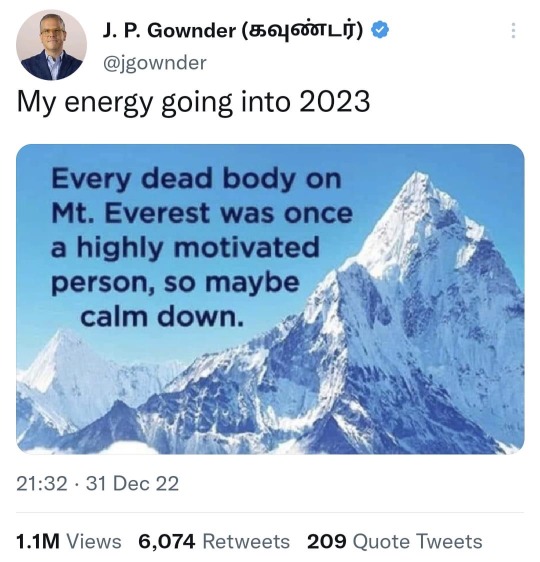
You stay alive without drive 👍
#dank memes#fresh memes#funny memes#memes#lol#funny but true#so true#me irl lol#funny but not funny haha#oh no lol#adulting#mental health#mount everest#mt everest#mountains#mountain climbing#rock climbing#motivation#motivational#calm down#calmingvibes#stay calm#new years resolution#new years#new year#stay alive#keep yourself alive#driven#drive#no motivation
646 notes
·
View notes
Text

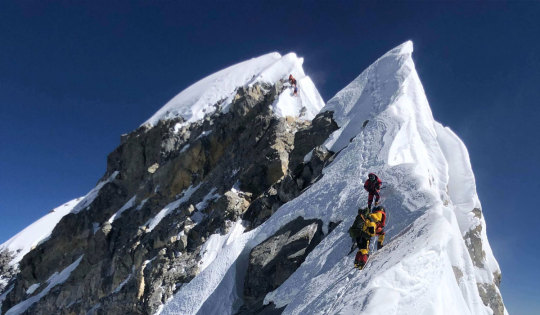
Why are Hundreds of Climbers Heading into the ‘Death Zone’ on Mt Everest This Spring?
Thick murky clouds fill the sky, with freezing winds carrying snow faster than 100 miles per hour. With a frigid –30 degrees Fahrenheit temperature, life-threatening snowstorms and avalanches are frequent.
And these are typical conditions on the world’s highest mountain: Mount Everest.
The behemoth towers 29,032 feet (8,849 meters) between Nepal and Tibet in the Himalayas, with its peak surpassing most clouds in the sky.
An attempt to climb Everest requires months, sometimes years, of training and conditioning – even then, reaching the summit is far from guaranteed. In fact, more than 300 people are known to have died on the mountain.
And yet the mountain still draws hundreds of climbers who are determined to reach its peak every spring. Here’s what it takes to make the climb and what has motivated some climbers to summit the world’s highest peak.
‘I thought I was in pretty good shape’
Dr. Jacob Weasel, a trauma surgeon, successfully summited Everest last May after conditioning for nearly a year.
“I would put on a 50-pound backpack and do two hours on a stair stepper with no problem,” Weasel said. “So, I thought that I was in pretty good shape.” However, the surgeon said he was humbled after discovering that his fitness was no match for the lofty athleticism required by the mountain.
“I would take five steps and have to take 30 seconds to a minute to catch my breath,” Weasel recalled of his struggle with the lack of oxygen available while ascending Everest.
Climbers aiming for the summit usually practice an acclimatizing rotation to adjust their lungs to the thinning oxygen levels once they arrive on the mountain. This process involves mountaineers traveling upward to one of the four designated camps on Everest and spending one to four days there before traveling back down.
This routine is repeated at least two times to allow the body to adapt to declining oxygen levels. It increases a climber’s chances of survival and summiting.
“If you took somebody and just plopped them up at the high camp on Everest, not even on the (top), they would probably go into a coma within 10 to 15 minutes,” Weasel said.
“And they would be dead within an hour because their body is not adjusted to that low of oxygen levels.”
While Weasel has successfully summited dozens of mountains, including Kilimanjaro (19,341 ft), Chimborazo (20, 549 ft), Cotopaxi (19,347 ft), and most recently Aconcagua (22,837 ft) in January, he said none of them compares to the high-altitude of Mount Everest.
“Because no matter how well you are trained, once you get to the limits of what the human body can take, it’s just difficult,” he continued.
At its highest altitude, Everest is nearly incapable of sustaining human life and most mountaineers use supplementary oxygen above 23,000 feet. The lack of oxygen poses one of greatest threats to climbers who attempt to summit, with levels dropping to less than 40% when they reach the Everest “death zone.”

Tents of mountaineers are pictured at Everest base camp in the Mount Everest region of Solukhumbu district on April 18, 2024.
‘It’s difficult to survive up there’
The first target for mountaineers is Everest base camp at approximately 17,000 feet, which takes climbers about two weeks. Then they ascend to the three remaining camps stationed along the mountain.
Camp four, the final one before the summit, sits along the edge of the death zone at 26,000 feet, exposing climbers to an extremely thin layer of air, subzero temperatures, and high winds powerful enough to blow a person off the mountain.
“It’s difficult to survive up there,” Weasel said. He recalls passing bodies of climbers who died on the mountain – which isn’t uncommon. The bodies of the fallen mountaineers are well-preserved, exhibiting little to no decay due to the intense cold temperatures.
“I am probably more familiar with death and the loss of life than most people,” the surgeon said. “For me it was just a reminder of the gravity of the situation and the fragility of what life is… even more so motivation for appreciating the opportunity.”
High-altitude cerebral edema (HACE) is one of the most common illnesses climbers face while attempting to summit. “Your brain is starved of oxygen,” Weasel said.
HACE results in the brain swelling during its attempt to regain stable oxygen levels, causing drowsiness, trouble speaking and thinking. This confusion is often accompanied by blurred vision and sporadic episodes of delusion.
“I had auditory hallucinations where I was hearing voices [of friends] that I thought were coming from behind me,” Weasel recalled. “And I had visual hallucinations,” he added. “I was seeing the faces of my children and my wife coming out of the rocks.”
Weasel recalled crossing paths with a friend, Orianne Aymard, who was trapped on the mountain due to an injury. “I remember staring at her for like five minutes and just saying, ‘I’m so sorry,’” Weasel said.
“I’ve spent over a decade of my life training to help people as a surgeon, and being in a position where there’s somebody who requires your help and you are unable to offer any assistance… that feeling of helplessness was tough to deal with,” Weasel said.
Aymard survived. She was rescued and suffered from several broken bones in her foot, in addition to severe frostbite on her hands. Despite all her injuries, Aymard is considered one of the lucky ones.

Mountaineers climbing during their ascend to summit Mount Everest on May 7, 2021.
‘Their bodies will get frozen into the mountain’
Everest has long been a tomb for climbers who have succumbed to harsh conditions or accidents on its slopes.
When a loved one or fellow climber is severely injured or dies on the mountain, it’s routine to leave them behind if you’re unable to save them, according to Alan Arnette, a mountaineer coach who summited Everest in 2014.
“What most teams do out of respect for that climber, they will move the body out of sight,” he said. And that’s only if they can.
“Sometimes that’s just not practical because of the bad weather, or because their bodies will get frozen into the mountain,” Arnette said. “So, it’s very difficult to move them.”
Seeing a corpse on Everest is comparable to seeing a horrible car accident, according to the mountain coach. “You don’t turn around and go home,” Arnette said. “You respectfully slow down… or say a prayer for that person, and then you continue.”
It’s been 10 years since the single deadliest accident on the world’s highest mountain, after an avalanche killed 12 Sherpa guides. And 2023 was recorded as the deadliest year on Everest, with 18 fatalities on the mountain – including five people that are still unaccounted for.
The process of recovering bodies is extensive, sometimes impossible. Helicopter rescues and search missions are challenging due to the high altitude and frequently treacherous conditions, resulting in some rescuers dying in their attempt to save others.
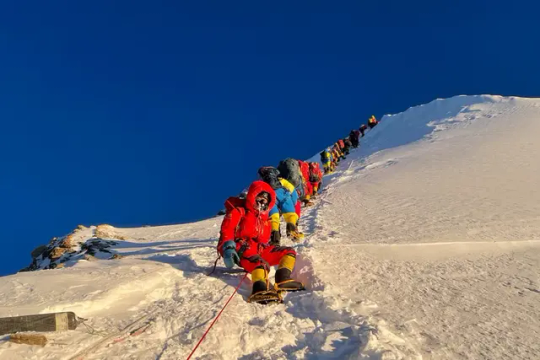
Mountaineers as they climb during their ascend to summit Mount Everest on May 12, 2021.
‘Watching the sunrise from 29,000 feet’
The 3,000 feet climb from camp four to the summit can take anywhere from 14 to 18 hours. Therefore, mountaineers typically leave the camp at night.
“That entire night was cold,” Weasel recalled. “It’s dark, it’s windy.” But it was proven to be worth it in the morning, he said.
“Watching the sunrise from 29,000 feet and having that pyramid of Everest’s shadow projected onto the valley below you…,” Weasel said. “It was probably one of the most beautiful things I’ve ever seen in my life,” he continued.
“It’s weird standing up there and knowing that everything else on the planet is below where you’re standing.”
The size of the mountain is humbling, the surgeon said. “I’ve never felt so small,” he recalled. “That mixture of humility and connectedness with something bigger than yourself is the proper place from which we ought to approach our existence on this planet.”
Like Weasel, Arnette summited at sunrise, and experienced this same feeling of “smallness.” At the top there were “more mountains than you can count,” Arnette remembered. “It was a sense of enormous gratitude and at the same time I knew I had to get back down.”
After about 20 minutes to an hour, climbers typically start to descend back to the base of the mountain.
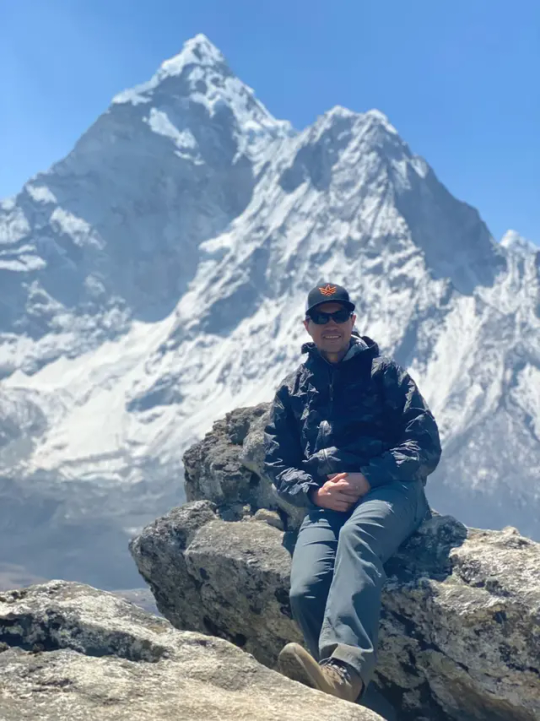
Jacob Weasel.
‘Bigger than yourself’
Before leaving for Nepal, Weasel was gifted an eagle’s feather as a beacon for his Native American heritage.
He was determined to plant the feather on top of Everest “as a symbol of our people and what we’ve endured for the past several hundred years,” Weasel said. “Showing that our spirit is not broken, but we’re able to rise above the things that have happened to us,” he added.
“I remember planting that eagle’s feather on the top of the world and the feeling of real privilege that I felt in representing our people.” And this is why he decided to summit Everest, to be an example that anything is possible for young Native children and his tribe.
“Knowing what it’s like up there, for me personally, the only real justification for going and putting your life, and other lives, at risk is if you’re climbing for a reason that is much bigger than you,” said Weasel.
Arnette attempted to climb Everest three times before he successfully summited.
“My first three tries, I wasn’t clear on my why,” Arnette said. When his mother was diagnosed with Alzheimer’s disease, he looked at his purpose for climbing differently.
“I wanted to do it to raise money for Alzheimer’s and honor my mother,” Arnette said.
There are approximately 300 people that have been issued a permit from the Nepal government to climb the mountain this year, according to Arnette. And he said the number is down from previous years.
“I think one of the reasons is because we had the 18 deaths last year, and people realize that Mount Everest is a dangerous mountain.”
However, he doesn’t believe that should deter climbers from attempting to summit. “I’m a big believer that when you go climb these mountains that you come home a better version of yourself,” Arnette said.
“Everest has become too commercialized with ‘you’re stepping over dead bodies’ and ‘it’s littered with trash,’” the mountain coach said. “The reality is that it is a very small degree all of that, but there’s a lot of joy that people get out of doing it,” he continued.
“And that’s the reason that we climb mountains.”
By Kara Nelson.

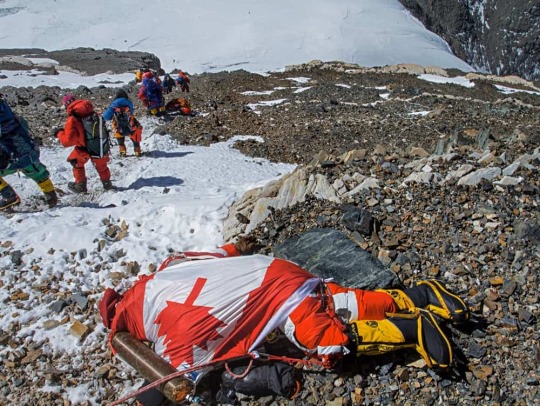
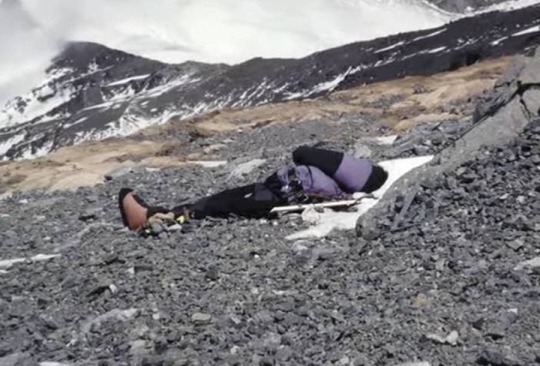


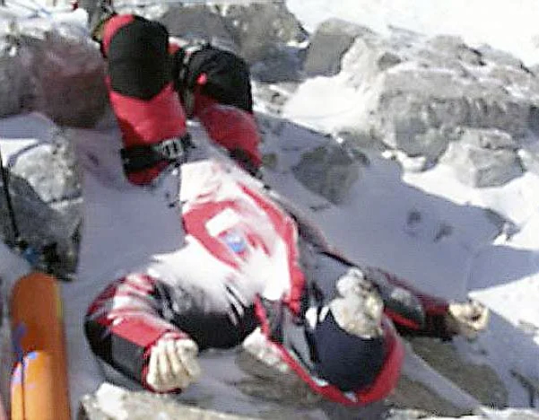
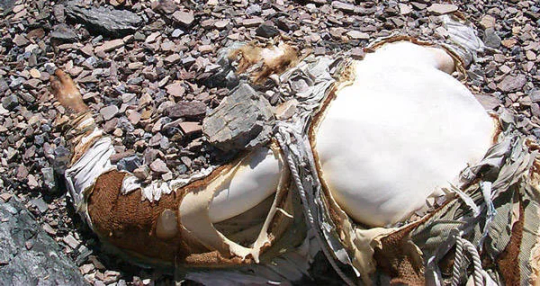
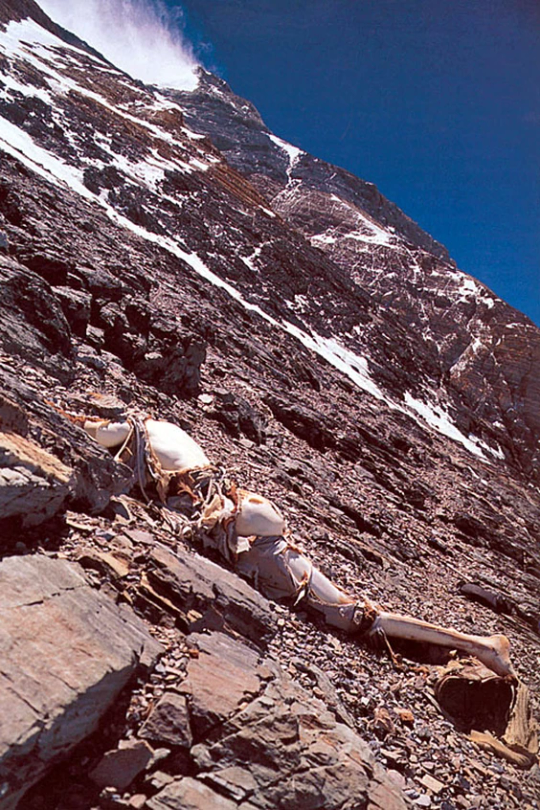

#Mt Everest#Mount Everest#Everest#The Death Zone#Why are Hundreds of Climbers Heading into the ‘Death Zone’ on Mt Everest This Spring?#world’s highest mountain#the Himalayas#mountain climbing#death on a mountain#history#history news#long reads#long post#long story
32 notes
·
View notes
Text

Lizzie’s gonna plant her flag on top of Mt. Everest! I hope she doesn’t fall!!
18 notes
·
View notes
Text

The mountain call
#the summit of the gods#habu joji#sotg#les sommet des dieux#mountaineering#mt everest#small sketch turned into big drawing… classic#I initially thought sotg was going to be a horror movie after seeing the first trailer LOL#I love how insane the proximity of the summit can make you#dogoryx
20 notes
·
View notes
Text
#r/196#196#r/196archive#/r/196#rule#meme#memes#shitpost#shitposting#tattoos#tattoo#body art#travel#mt everest#nepal#traveling#body modification#body jewelry
7 notes
·
View notes
Text
7 years ago my doctor died on Mt Everest. He was there because his previous expedition was cut short by the earthquake that he managed to survive. A few weeks before he went this last time he stopped by my work for coffee and I had a private chance to ask him if he had lost his damn mind. He just laughed.
When I had met him 15 years earlier we were both homesick transplants who felt shipwrecked. He made a home and family here, and earned the affection and respect of the community. That didn't happen for me, lol.
He was a great doctor. He saved my grandsons life one night in the ER and after 3 tries at medicating my depression he said "You're depressed because you're homesick. No pill will fix that. Make friends here or go back to Philly." He was right.
He faced middle-age with an enthusiasm that amazed me. He took up flying, scuba diving, and mountain climbing. He loved his kids, his patients, and he loved life. He was an amazing man and a terrific doctor. I haven't been to a doctor since he died. If he were here and heard me say that he would bonk me on the head with my file and tell me to stop being so dumb.
According to his daughter he will be cremated, as he wished. I hope they have a memorial service for him, I'd like to go.
Gone, but never forgotten.
Rest in peace.

I just realized that I hadn't written that his body had been recovered, after 7 years, from a crevasse on Everest a few days before I wrote this.
17 notes
·
View notes
Text
So I sometimes sub/ work at my local school, and this past week I was helping out in a very tough 4th grade classroom. For science we put on a video about mysteries surrounding Mt. Everest, and not only did Green Boots come up, but the kids shared facts they knew about the mountain, and then proceeded to ask me if I knew any facts.
And I, who was rereading KOTLC before work that day, froze because all I could think of was the Everblaze finale. My brain is going “Ummm, it’s where Keefe Sencen’s trauma started?”
Anyways, I ended up going with “It’s in the Himalayas”, since the video hadn’t mentioned that.
16 notes
·
View notes
Note
Hi! I took a gander into Sam's IMDb to check his film portfolio to see what I have missed. It showed Everest as "In production"! Any insight on this film? Looks like this could be another great hit for him! Great cast involved. Looks like this movie has taken over 10 years to start production! Wow. I wonder why?
Btw...watched First Light...such a great movie! Proves how talented SamShine is even in his early acting years. He is a man that ages like a fine wine or a fine 20 year old scotch whiskey 😉😍
Hi there. As far as I know, the movie has been put on hold due to scheduling conflicts. I don't think it's happening. 👇
https://parade.com/1223834/paulettecohn/outlander-star-sam-heughan-everest-movie/
But it looks like Sam may be part of a Mt Everest documentary. 👇
https://twitter.com/TheScotsman/status/1700842384894890360?t=6_W6smbtOEuJH9FDTUuMgA&s=19

And here he talks about doing the Everest marathon, which I guess is a 14 day trek to Everest Basecamp, altitude 17,000 feet 👇
https://twitter.com/fra_shiny/status/1701173906873233508?t=q50WyFkSJtKOfQRuFrPe9g&s=19

Sam has always been interested in Mt Everest, so it looks like he's going to do a related project no matter what.
I share his Mt Everest interest, it's always been fascinating to me what propels people to want to climb a 29,000 ft mountain. I got really obsessed a few years ago and watched and read everything on it. Also, I'd follow climbers on IG and watch their trek to the summit. They can only climb during May due to the weather. Fascinating stuff.
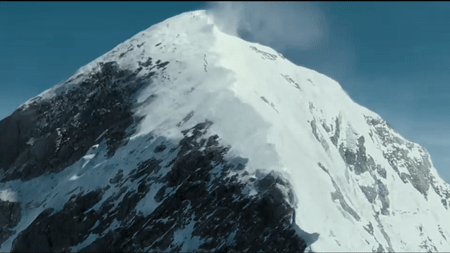
37 notes
·
View notes
Text
I needed a break from social media. So much has happened in wrestling. Sting is retired. Hoping he takes a non- wrestling role in AEW. HOOK still showing he's a legit bad ass. Darby being real in the ring got to me. Please let him come back from Mt. Everest safe and okay. I hate Don Callis and think Will Ospreay needs take Kyle and get away from him,but Will has shown why he belongs in AEW already. Proud of him and his Mrs. for all she's been through. Swerve should have won. Wardlow winning to hand the title to Adam Cole is stupid. But, Wardlow is just another Killswitch. An I QUIT match in Toronto between Adam Copeland and Christian. Holy shit!!!
Swerve and his woman are good together. Don't care about most relationships, but knowing her history somewhat, he is good for her and her good for him. Same with Will Ospreay and Alice aka Alex Windsor.
#swerve strickland#aew#hook aew#christian cage#nick wayne#will ospreay#samoa joe#sting#darby allin#adam copeland#mt everest
10 notes
·
View notes
Text
"Where is my dream vacation? That's easy, I want to lay on a couch with you.. nowhere special except in your arms, which is a really special place. I don't need the ocean spraying foam on me, I don't need sand in my hair.. I don't need to climb Mt Everest. I just want to be with you, that's the perfect vacation to me and we don't have to spend any money at all.. just your time."
So true.. but in all honesty, anywhere is better when you are there - eUë
#dream vacation#in my dreams#with you#in your arms#on the couch#cuddles#cuddle#cuddle with me#cuddle me#special place#special#beach#mt everest#vacation#going on vacation#sand#i love you#affection#i want you#happy place#happy#happily ever after#happiness#spilled ink#spilled thoughts#spilled words#love quotes#love#love quote life quotes#love quote for her
111 notes
·
View notes
Text
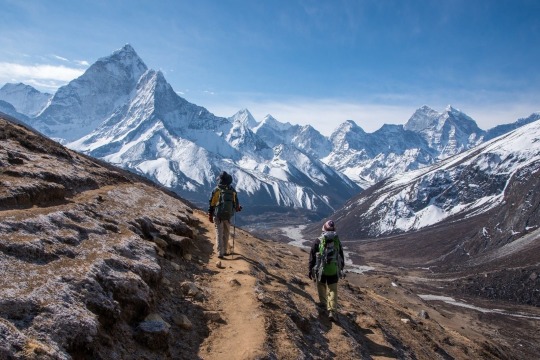
a trail to Mt Everest base camp
18 notes
·
View notes
Text
When I rest I feel utterly lifeless except that my throat burns when I draw breath ... I can scarcely go on. No despair, no happiness, no anxiety. I have not lost the mastery of my feelings, there are actually no more feelings. I consist only of will. After each few metres this too fizzles out in unending tiredness. Then I think nothing. I let myself fall, just lie there. For an indefinite time I remain completely irresolute. Then I make a few steps again.
— Reinhold Messner, 'The Crystal Horizon', on summiting Mt Everest without using supplemental oxygen
#will#determination#surviving depression#mt everest#mountaineering#mountain climbing#quotes#surviving illness
3 notes
·
View notes
Text
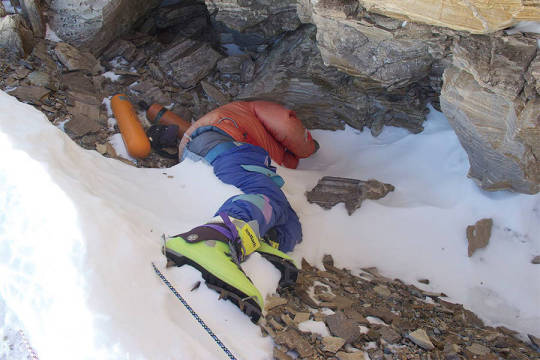

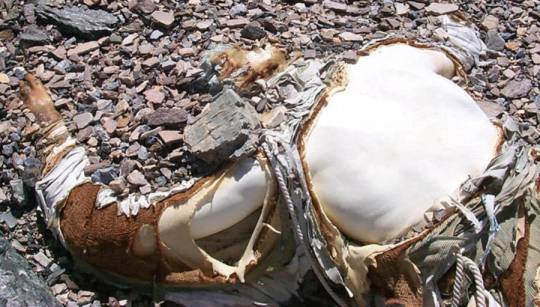
There are an estimated 200 bodies on Mt. Everest, Earth's tallest peak, and climbers often use them as markers to determine how close they are to the top.
These are three of the four most well-known bodies that currently are, or were at one time, on the mountain:
"Green Boots": the real identity of the body climbers refer to as "Green Boots" is presumed to be Tsewang Paljor, who perished in 1996. Not pictured here is the body of David Sharpe, who, when he stopped at Green Boots' cave to rest, slowly froze to death, even while approximately 40 other climbers passed by him dying and did nothing to help.
Hannelore Schmatz became the first German and the first woman to die on the mountain. She succeeded in reaching the summit, but ignored the warnings of her Sherpa on the way back down and camped overnight in the death zone. While she did survive the night, she finally succumbed to exhaustion, low oxygen, and frostbite on her way back to base camp, dying just 330 feet from safety. Her body is no longer visible on the mountain and has either been swept away by the high winds or buried under the snow.
George Mallory was the first person to attempt to climb Mt. Everest in 1924, using "primitive climbing equipment and heavy oxygen bottles." His upper torso, half of his legs, and his left arm were found in 1999. He was dressed in a tweed suit and a rope injury around his waist suggested he'd been climbing with someone else when they fell off a cliff.
#creepy#morbid#macabre#facts#did you know#mt everest#mountain climbing#death#dead body#mountain climbers#tsewang paljor#hannelore schmatz#george mallory#green boots#all that's interesting#interesting#places#outdrs#outdoors#hiking#images
25 notes
·
View notes
Text

BWAHAHAHAHAAAH!!!
#mountain climbing#mountaineering#mt everest#climbing#feces#fecal matter#rich people#justice#bourgeoisie#nepal news#tourism#nepal tour#good news#karma#nature#hiking
3 notes
·
View notes